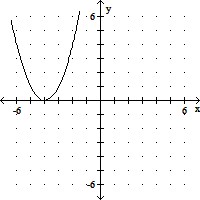Identify the domain and the range of the relation from the graph.
A. Domain: (-?, ?)
Range: [0, ?)
B. Domain: (-?, ?)
Range: (-?, ?)
C. Domain: (-?, 0)
Range [-4, ?)
D. Domain: (-?, 0);
Range: [0, ?)
Answer: A
You might also like to view...
Solve the problem.An auditorium has 15 rows with 10 seats in the first row, 12 in the second row, 14 in the third row, and so forth. How many seats are in the auditorium?
A. 360 B. 390 C. 255 D. 300
Find src="https://sciemce.com/media/3/ppg__cognero__6.7_Ratios_Proportions_and_Problem_Solving__media__0793e385-c6bc-4bb0-9407-7e9671271906.PNG" class="wirisformula" align="middle" style="vertical-align: middle;" data-wiris-created="true" varid="variable_id_field" variablename="impvar_eb47d59b27cf460793dc55879" /> and 



?
?
A.
B.
C.
D. 
E.
Determine whether the relation represents a function. If it is a function, state the domain and range.
A. function domain: {Alice, Brad, Carl} range: {cat, dog} B. function domain: {cat, dog} range: {Alice, Brad, Carl} C. not a function
Solve the problem.If the population of a small town is modeled by 14t2 + 7500, where t is in years and  corresponds to the year 1960 and
corresponds to the year 1960 and  corresponds the year 1970, what was the population of the town in 1980?
corresponds the year 1970, what was the population of the town in 1980?
A. 7626 B. 7556 C. 7500 D. 7514




